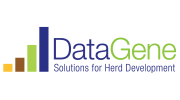In the fast-paced world of modern farming, data is transforming the way we manage livestock. Genetic information, in particular, has emerged as a powerful tool for improving productivity, sustainability, and overall herd performance. By tapping into genetic data, farmers can develop smarter breeding programs, promote disease resistance, and future-proof their operations.
Enter DataGene—a leading provider of genetic evaluations and tools designed to help Australian farmers harness the potential of dairy cattle genetics. Paired with its DataVat web portal, this system provides farmers with tailored, actionable insights into their herd’s genetic potential, traits, and performance.
This blog is your practical guide to understanding the importance of genetic data in livestock management and how to leverage tools like those provided by DataGene for genetic improvement. From navigating the indices that matter, to integrating genetic insights into your dairy cattle breeding and management decisions, we’ll explore how these resources can revolutionise the way you farm.
DataGene: What is it and how does it work?
DataGene is a key player in advancing dairy management in Australia. As an independent, industry-owned organisation, it serves as a central hub for genetic evaluations, data management, and decision-making tools tailored for dairy and livestock farmers. Established in 2016, DataGene gives farmers access to Australian Breeding Values (ABVs) and other genetic tools to improve herd productivity, animal health, and overall sustainability.
Key Functions of DataGene include:
- Genetic evaluations: Publishing ABVs for over 40 economically important traits which include metrics for production, health, fertility, and feed efficiency, to guide genomically driven breeding programs.
- Breeding indices: Offering customised indices like the Balanced Performance Index (BPI), Health Weighted Index (HWI), and Sustainability Index (SI) to focus on specific farming goals.
- Data management: Consolidating herd data through the Central Data Repository (CDR) to streamline access to valuable insights.
- Genomic testing: Providing farmers with DNA-based predictions for livestock performance to improve early decision-making and genetic improvement programs.
The DataVat web portal is DataGene’s online interface, offering secure and tailored access to herd information, reports, and tools derived from its Central Data Repository. It serves as a one-stop shop for farmers to access the insights they need for data-driven management of genetic gain.
Features of the DataVat Portal include:
- Customised reports: Farmers can access herd-specific reports on performance, genomic estimated breeding values, genetic variants, and other critical metrics.
- Interactive tools: Dynamic tools allow users to analyse data, compare options, and plan improvements.
- Public and private access: While some information is freely available, personalised reports and sensitive data are securely accessible only to herd owners or subscribers.
- Integration: DataVat connects with on-farm management software, enabling farmers to align on-ground operations with genetic insights.
Learn how genomic testing can improve the welfare of your herd.
Core indices and traits
DataGene tracks a comprehensive set of traits and breeding indices that support genomic selection in cattle herds based on key genetic markers. These tools help farmers focus on the genetic attributes most relevant to their goals, ensuring healthier, more productive, and sustainable herds.
Genomic breeding values: Core breeding indices
Balanced Performance Index (BPI):
- Purpose: The BPI is an economic index designed to improve the lifetime profitability of dairy cattle by balancing production, health, and type traits.
- Traits included: Milk production, fertility, mastitis resistance, feed efficiency, and longevity.
- Usage example: A farmer aiming to boost overall herd productivity while reducing feed costs can use the BPI to select sires with strong performance in production and feed efficiency traits.
Health Weighted Index (HWI):
- Purpose: The HWI focuses on improving dairy cattle health-related traits, placing higher emphasis on fertility, mastitis resistance, and feed efficiency.
- Traits included: Fertility, longevity, health, and workability traits.
- Usage example: A dairy farmer experiencing high incidences of mastitis can prioritise sires with high HWI scores to reduce veterinary costs and improve herd health.
Sustainability Index (SI):
- Purpose: This index promotes breeding for reduced greenhouse gas emissions intensity by emphasising traits like production, survival, and feed efficiency.
- Usage example: Farmers committed to sustainability can use the SI to breed dairy cattle that produce more milk with lower emissions, aligning with environmental goals and consumer expectations.
Genetic variants: Key traits tracked
Production traits:
Milk yield, protein content, and fat yield are key performance indicators for dairy cattle.
- Genomic selection impact: By selecting sires with higher production trait scores, farmers can improve milk output and component quality.
- Usage example: A farmer wanting higher protein levels in milk for cheese production can select sires with strong protein yield traits.
Fertility:
Fertility traits include calving interval and conception rates.
- Genomic selection impact: Improved fertility reduces calving gaps and boosts lifetime productivity for dairy cattle.
- Usage example: Selecting sires with strong fertility traits helps achieve a more consistent calving schedule.
Health and Longevity:
Traits include disease resistance, mastitis resistance, and herd survival rates.
- Genomic selection impact: Healthier dairy cattle live longer, incur fewer veterinary costs, and maintain higher productivity over their lifetimes.
- Usage example: A farmer can select sires with a high Mastitis Resistance ABV to breed replacement cows with improved mastitis resistance and thereby improve herd health.
Feed Efficiency:
Efficiency traits measure the ability of dairy cattle to convert feed into milk.
- Genomic selection impact: This supports lower feed costs and higher profitability.
- Usage example: Farmers facing high feed costs can breed cows that produce more milk with the same or lower feed intake.
Type and Workability Traits:
Traits like udder conformation, milking speed, and temperament impact dairy cattle performance and management ease.
- Genomic selection impact: Improved workability traits lead to easier handling and better milking efficiency.
- Usage example: Farmers can reduce labour requirements and time spent milking by selecting sires with favourable temperament ABVs and milking speed traits.
The benefits of DataGene
Accessing and tracking genetic data through DataGene and its DataVat portal revolutionises livestock management and breeding programs by supporting:
- Smarter breeding decisions: Leverage ABVs and indices like BPI, HWI, and SI to focus on traits that align with your goals, such as productivity, health, or sustainability.
- Increased efficiency: Genomic testing enables more precise decision-making, reducing input costs and improving outputs.
- Healthier, more productive herds: Focus on traits like fertility, mastitis resistance, and longevity to improve herd performance and reduce veterinary expenses.
- Data-driven insights: With DataVat, farmers gain secure access to customisable reports and tools that make genetic data actionable and easy to interpret.
- Sustainability: Select for traits that reduce greenhouse gas emissions intensity and align with environmental goals.
XytoVet and DataGene
At XytoVet, we specialise in livestock genotyping, helping farmers unlock the full potential of genetic resources like DataGene. With our expertise, you can:
- Decode complex genetic data to align with your herd improvement goals.
- Develop tailored breeding programs using the insights from DataGene and DataVat.
- Maximise the benefits of genomic testing to drive long-term success in your operation.
Discover how genomics can transform your approach to livestock management. Contact XytoVet today to explore how we can help you achieve healthier, more productive herds while pursuing your farming goals.










